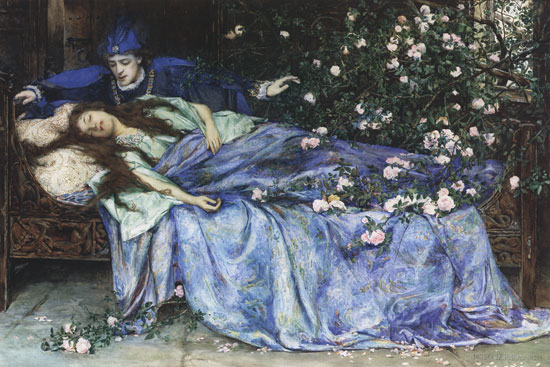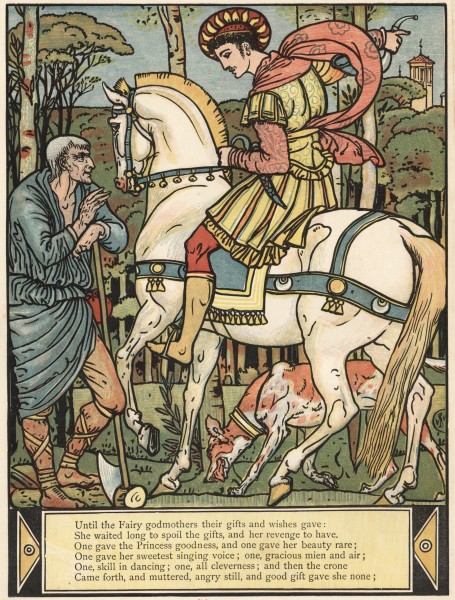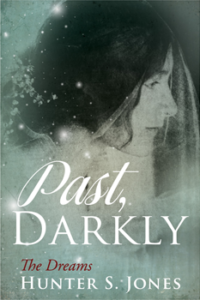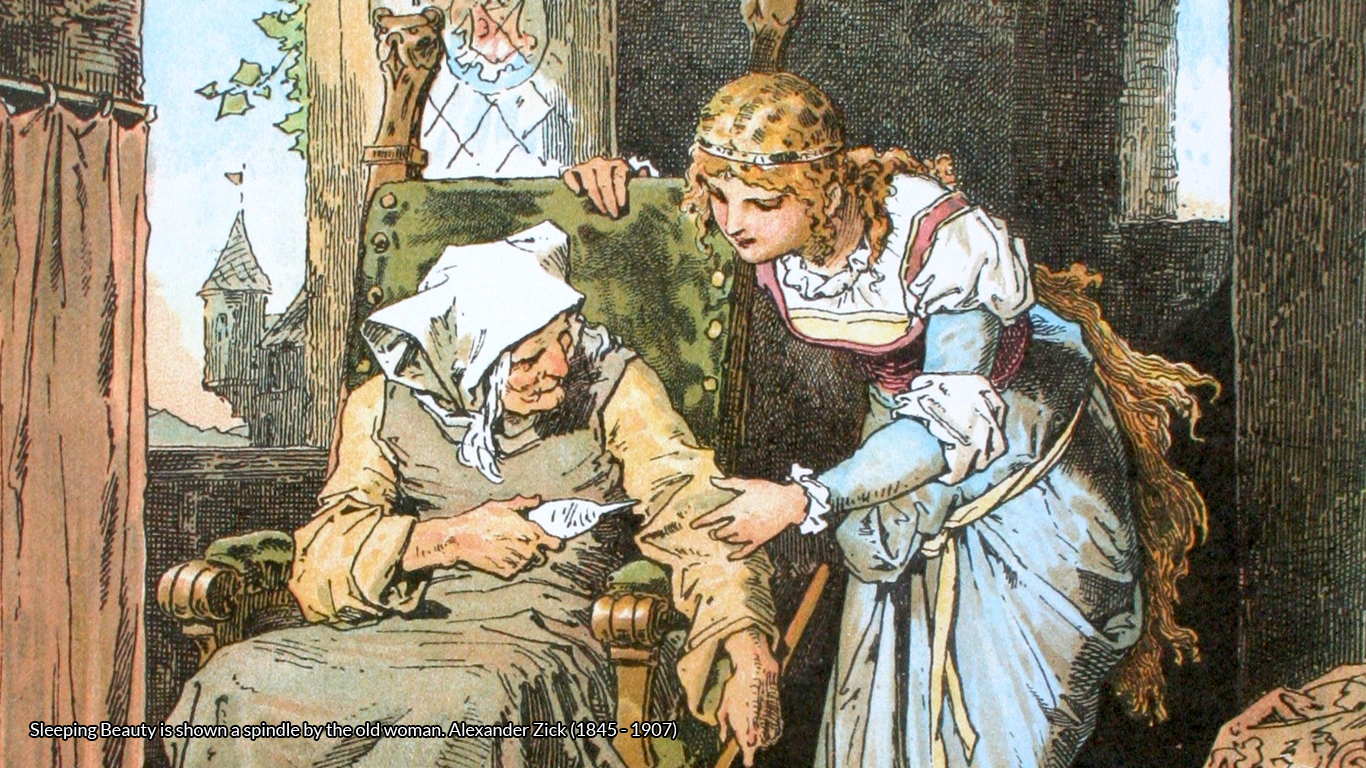Fairy tales symbolize aspects of our inner psychology, and contain wisdom that is not apparent at first glance. Compared to other fairy tales, Sleeping Beauty betrayed us by only sleeping. Among the many heroines found in fairy tales, even those who married into happily–ever–after romances, Sleeping Beauty’s lethargy appears on the surface as a lack of spirit. Yet, Sleeping Beauty has an allure that is undeniable. Her story has retained a place in our traditions. Like most fairy tales, time has reshaped her dilemma and salvation. She has endured each reincarnation with a glimmer of the original story intact. It is Sleeping Beauty’s ability to sustain her existence, even from a bed, that captivates us. We may not like her passivity, but we have to yield to her enduring presence and her story’s tenacious spirit. Let’s delve into the various adaptations of “Sleeping Beauty” and explore this enigmatic story to better understand the appeal of this passive princess, whose story is not one of sleeping and passivity, but of transformation.
Many people suggest that the first sleeping beauty story is “The 9th Captain’s Tale,” found in The Book of the One Thousand and One Nights, a collection of Middle Eastern and South Asian stories and folk tales dated from the 8th century to the 13th century. The tale’s exotic setting begins with a familiar conflict: A woman longs for a child and goes to the extreme in asking for a child, even if it is a girl; “give me a daughter, even if she can’t endure the odor of flax.” Her wish is granted. As the child grows, the Sultan’s son is smitten by her beauty. Then, in an accident, the girl’s hand touches flax and she falls into a death-like sleep. Her distraught parents transport her body to a shrine on a remote island. The Sultan’s son remains very much in love with her and visits her memorial. A kiss from the forlorn lover awakens the sleeping maiden and they have sex for forty days (like you do.)
However, the Sultan’s son cannot stay on the island and he leaves her. In retaliation, the young woman uses a magical ring of Solomon and wishes for a palace to be built next door to the Sultan’s. She also asks to be transformed into an even greater beauty; and that she be unrecognizable and irresistible to her former lover.
The Sultan’s son soon espies his beautiful neighbor and falls in love. He sends her gifts to persuade her, yet she refuses all advances. Desperate, the Sultan’s son begs to know how he can prove that he is worthy enough to be her husband. She tells him that he must wrap himself in a shroud and allow himself to be buried and mourned as dead. The young man agrees, has himself wrapped in funeral clothing, and is buried. Satisfied, the young woman comes to the palace, removes the Sultan’s son from his grave, and reveals her identity. “Now I know,” she says, “that you will go to any length for the woman you love.”
What is intriguing about this version of “Sleeping Beauty” is that it is about both lovers and their journeys of transformation. Each one experiences a death; an end to their lives as children. Each one is prepared for a funeral and buried by their family. The Sultan’s son is initially responsible for awakening Sleeping Beauty, but their relationship is not one that is sanctioned by their culture. When she returns to him, she is changed — transformed by magic. The Sultan’s son, in accepting her condition of marriage, also agrees that his privileged life as a child must end. When she revives him from the dead, they are now equal and their marriage is one between adults. Who could not admire this Sleeping Beauty? She is a divine bride, with the ability to call upon magic at her will, and smart enough to test her lover. By reviving him, she proves that she has innate powers. He may be a Sultan’s son, but she is confident that she is equal to him. This same evocation to the power of female sexuality and its transformative influence is echoed in the Song of Solomon, with the advice to “awaketh not love before it so desires.”

In the 17th century, two European versions of the sleeping beauty story became popular. Firstly, “Sun, Moon, and Talia” was published by an Italian storyteller Giambattista Basile, in his collection known as The Pentamerone. Italian fairy tales were some of the earliest fairy tales to be published in Europe. These writings were bawdy, sexually charged, and not intended for children. In Basile’s version, collected from female storytellers around Naples, Sleeping Beauty is known as Talia. By asking wise men and astrologers to predict her future after her birth, her father — a powerful lord — learns that Talia will be in danger from a splinter of flax. The splinter later causes what appears to be Talia’s death; however, it is discovered that actually she is in a long, deep sleep. She falls into this sleep when a splinter of flax is embedded under her fingernail. She lies alone in a small house, hidden deep within the forest. One day, a King discovers the sleeping maiden while he is hawking. Finding her beautiful, and unprotesting, he has sex with her. Talia, oblivious to the King’s ardent embraces, sleeps on. The King leaves the forest, returning to his castle and his childless wife. In some versions of the story, instead of a wife he returns to his mother who is a jealous cannibal. Nine months later, a sleeping Talia gives birth to twins named Sun and Moon. One of the hungry infants, searching for their mother’s breast, suckles her finger and pulls out the flax splinter. Freed of her curse by the removal of the splinter, Talia wakes up and discovers her children.
The King goes back to the forest and finds Talia awake, tending to their son and daughter. He takes them to his estate, where his barren wife (or jealous cannibalistic mother) becomes bitter and jealous. As soon as the King leaves for battle, the wife orders her cook to murder Sun and Moon, then prepare them as a feast for her husband when he returns. The kindhearted cook hides the children and substitutes goat in a dizzying variety of dishes. The wife then decides to murder Talia by burning her at the stake. As Talia undresses, each layer of her luxurious clothing beckons the King, as bells were sewn into her seven petticoats. Eventually the King hears the sound and comes to Talia’s rescue. The jealous wife is put to death, the cook reveals the children are safe, and the King and Talia are united in a proper marriage.
Later in the same century, a Frenchman named Charles Perrault wrote “La Belle au bois Dormant,” a version of Sleeping Beauty which is similar to Basile’s story and draws on popular French folklore. Fairy tale scholar Marina Warner (in her book From the Beast to the Blonde) notes that while rape and adultery were too scandalous for Perrault, he had no problem with the cannibalism of the Italian version. In Perrault’s version, the king becomes a prince and his dreadful mother is an ogress with a nasty temper and a fondness for human flesh. Sleeping Beauty’s children are to be served in a sauce, and then Sleeping Beauty herself is to be butchered. But the kind cook fools the ogress, hiding Sleeping Beauty and her children. When the ogress discovers the truth, she plots to cook them all in a stew with vipers and toads. But, the Prince arrives and saves his lover from harm, and destroys his mother instead.
Very touching and heartwarming, right?

Perrault’s story of a sleeping princess is familiar to us. At the christening of the princess, the king and queen ask seven good fairies to be the godmothers of their child. Each fairy is given a plate made of gold, and cups of sparkling jewels. During the feast, an older fairy enters and is presented with only a plate of china and a crystal drinking glass. This fairy wasn’t invited because she had moved long ago to a tower far away. Since no one had heard from her, everyone thought that she had died many years before.
Six of the fairies offer gifts — beauty, wit, grace, dance, song, and goodness to the princess. The older fairy, who is upset about being forgotten, places an enchantment upon the princess – someday she will prick her finger on the spindle of a spinning wheel and die. The seventh fairy, who hasn’t yet given a gift, wants to reverse the evil of the older fairy’s curse. There is only so much she can do according to the laws of magic. What the last good fairy decides to do is lessen the spell. The princess won’t die, she will fall into a deep sleep for one hundred years. Only the kiss of a king’s son will awaken her.
The King orders every spindle and spinning wheel in the kingdom to be destroyed, in order to save his daughter from the terrible curse. Sixteen years pass until one day, when the king and queen are away, the Princess wanders through the palace and finds an old woman with her spindle. The princess, who has never seen anyone spin before, asks the old woman if she can try. The curse is fulfilled as the princess pricks her finger on the spindle and instantly falls into a deep sleep. The old woman cries for help, but nothing can revive the princess. The king attributes this to fate and has the Princess carried to the finest room in the palace and placed upon a bed of gold and silver.
The king and queen kiss their daughter goodbye and leave, proclaiming the entrance to be forbidden. The good fairy who altered the evil prophecy is summoned to work an enchantment of protection. Having great powers of foresight, the fairy sees that the Princess will awaken in distress when she finds herself alone, so the fairy puts everyone in the castle to sleep. The fairy also creates a forest of trees, brambles and thorns that spring up around the castle, shielding it from the outside world and preventing anyone from disturbing the Princess.
A hundred years pass and a prince from another region of the country spies the hidden castle during a hunting expedition. His attendants tell him stories regarding the castle until an old man recalls his father’s words: Within the castle lies a beautiful princess who is doomed to sleep for a hundred years. The prince then braves the trees, brambles, and thorns which part at his approach, and enters the castle. He passes the sleeping castle folk and comes across the chamber where the Princess lies asleep on the bed. Struck by the radiant beauty before him, he falls on his knees before her. He kisses her, and the enchantment comes to an end. The princess awakens and converses with the prince for a long time. Meanwhile, the rest of the castle awakens and go about their business. The prince and princess are later married by the chaplain in the castle chapel.
The European fairy tales show a change in paradigm from the older narratives. Sleeping Beauty is still the center of the story, but she becomes an object to be acquired, at any cost. The European tales are focused on the men and their need for an heir. In “Sun, Moon, and Talia,” there is no sympathy for the first wife of the King. Her barrenness defines her as evil, and her replacement by the fertile bride is a victory. Talia can give birth even while she lies in a death-like sleep — taking her from the realm of human and making her a supernatural creature. Her impregnation is not a crime, even though to us it appears to be rape, but at that time it was considered an act through which the King engages with the magical, which proves not only his virility but also his divinity.
Fairy tales utilize emotionally evocative images to lure audiences into the web of the story; the underlying power struggle between the young bride and the older one. This would have been familiar to 17th–century listeners. The children’s names, Sun and Moon, align with ancient creation myths, many of which involve the birth of children through mystical means. Despite the emphasis on the male characters, the conflict between the women in the tales are also an important element. A new bride, brought to her husband’s family home, was firmly under the grip of her mother–in–law, while the dichotomy of the mother–in–law was threatened by a loss of power to a younger woman. Symbols of feminine power struggles can be found in the presence of the evil fairy, the old woman spinning, the barren wife, and the ogress mother. In this context, Perrault’s Prince achieves heroic status not only when he passes through the thorns and finds Sleeping Beauty, but also when he is able to protect her from the older woman and give her a place of authority by his side.

Sleeping Beauty evolved into a children’s story in the 19th century when the Brothers Grimm published their version, entitled “Little Briar-Rose.” While the Grimm’s retained the dark imagery from many of the older stories, the sexual connotations all but disappeared. Victorian publishers and readers wanted stories to be charming, and reflect the moral codes of the era. Innuendo replaced the overt and troubling activity of carnal sex and violence. But as modern writers from Angela Carter to Marina Warner have pointed out, these underlying themes are there. Briar Rose is “pricked,” the hedge is “penetrated,” and she sleeps not in a shrine but enclosed in a phallic tower. Yet, the narrative remains chaste and Victorian.
The age of sixteen is a time when menstruation can occur for women, hence the significance of the transformation—the awakening from a child to a woman. To avoid the pain of her secret, the Princess closed herself off from life entirely. The price of avoiding the pain was losing the joy of life. Not only did she fall asleep, but everyone in the castle fell asleep just where they were. The whole family blocked itself from life because the secret ruled their entire lives. That which is hidden and repressed will always work to have its influence recognized. The qualities that are necessary for the healing of the shameful secret are dormant, but await to be reintegrated into the wholeness.
The prince combines the archetypes of the king which he will become and the warrior. The king is the one who is responsible for their kingdom; he controls and makes decisions. The warrior has courage, and follows the instructions of the king. The prince represents our ability to use self-discipline to make responsible decisions and carry them out courageously. In the 1959 Disney movie Sleeping Beauty, the prince also carries the sword of truth—a sword which cuts away untruth to reveal the truth. The prince’s sword can reveal the hidden secret behind the princess’s shame.
The prince finds the castle covered with thorns and bushes. Castles are often a symbol of the heart; a part of the protective barrier placed around the family to keep out anyone or anything that may reveal the hidden secret. The thorns which protect those inside from intrusion also point inwards to keep wounding the family inside.
The turning point of the story occurs when the prince decides to explore the castle. The qualities of the prince are now activated and for the first time. There is a conscious decision to start the healing process.
The prince still lacks one vital quality, and that is wisdom. Without wisdom, his decisions will not have intention, and his actions will not produce the desired results. In Perrault’s version, the prince meets the old man outside the castle, who can remember what the castle looked like before the shadow of the evil fairy’s curse. The old man represents wisdom, and reminds us that wisdom often appears in forms we are not expecting and in places which we are not looking.
The prince now has a vision of what the future can be.
The prince rides on his horse with courage and responsibility. Since these qualities are at last revealed, the thorns surrounding the castle magically fall away. There is a circle of qualities needed in life which corresponds to the four fundamental archetypes proposed by Carl Jung of the king, magician, warrior, and lover. The corresponding qualities are authority, wisdom, courage, and compassion. The princess held the quality of compassion, but in a distorted form because of her family’s secrecy. The remaining three qualities are manifested by the prince, who already had authority and courage, then gained wisdom from the old man. Now that all four qualities are present, they can be used to heal the distorted concept of sexuality held by the princess.
The prince moves bravely into the castle until he finds the princess and she awakens. The kiss represents the coming together of wholeness and healing. The great secret is revealed, made whole, and the princess can now live a fulfilling, transformed life. With the secret released, the people in the castle who had also been asleep can return to normalcy.
The new wholeness is further symbolized by the wedding of the prince and princess.
And, they all lived happily ever after.
“Awaketh not love before it so desires, or before it is time for love and sexuality to accept the magic of transformation.”

The story of Sleeping Beauty plays a large part in my series, THE DREAMS, where I blend folklore, fairy tales and history to create a magical romance. You can find story 1 & 2 in this volume. Look for an accompanying Dream Journal to correspond with the stories. The final segment of the saga will be released in 2017.
Recommended Books from #FolkloreThursday
References & Further Reading
“The 9th Captain’s Tale” in The Book of the One Thousand and One Nights.
“Song of Solomon,” King James Version.
Giambatista Basile, 1634, “Sun, Moon, and Talia” in The Pentamerone.
Italo Calvino, 2013, Italian Folktales, Houghton Mifflin Harcourt, Boston.
Charles Perrault, 1697, “La Belle au bois Dormant.”
Jacob and Wilhelm Grimm, 1812, Kinder und Hausmärchen.
Alfred Lord Tennyson, 1842, “The Day-Dream.”
Maria Tatar, 2002, The Annotated Classic Fairy Tales, W. W. Norton & Company; 1st edition, New York.
Marina Warner, 1996, From the Beast to the Blonde: On Fairy Tales and Their Tellers, Farrar, Straus and Giroux, New York.
Jack Zipes, 2015, The Oxford Companion to Fairy Tales, Oxford University Press; 2 edition, New York.









